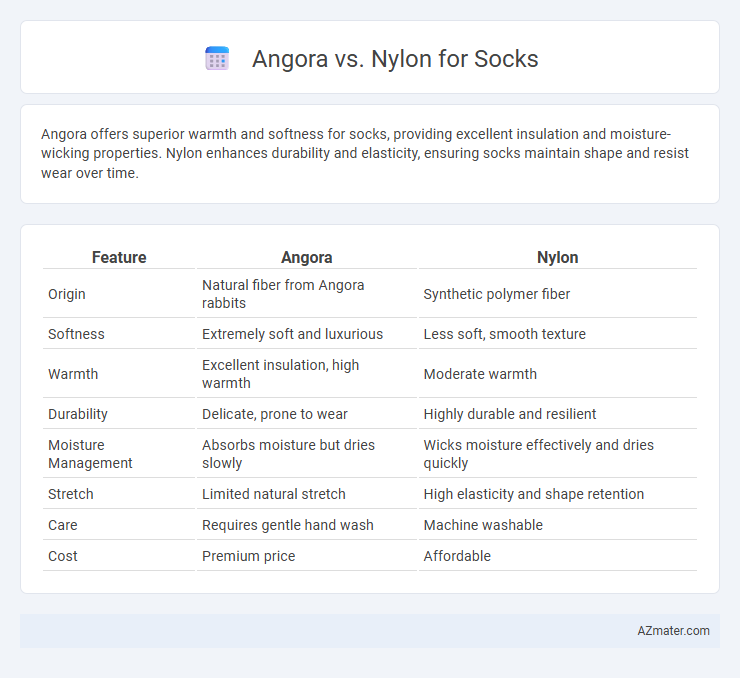Angora offers superior warmth and softness for socks, providing excellent insulation and moisture-wicking properties. Nylon enhances durability and elasticity, ensuring socks maintain shape and resist wear over time.
Table of Comparison
| Feature | Angora | Nylon |
|---|---|---|
| Origin | Natural fiber from Angora rabbits | Synthetic polymer fiber |
| Softness | Extremely soft and luxurious | Less soft, smooth texture |
| Warmth | Excellent insulation, high warmth | Moderate warmth |
| Durability | Delicate, prone to wear | Highly durable and resilient |
| Moisture Management | Absorbs moisture but dries slowly | Wicks moisture effectively and dries quickly |
| Stretch | Limited natural stretch | High elasticity and shape retention |
| Care | Requires gentle hand wash | Machine washable |
| Cost | Premium price | Affordable |
Introduction to Angora and Nylon Socks
Angora socks, made from the soft, lightweight fibers of Angora rabbits, offer exceptional warmth and moisture-wicking properties ideal for cold-weather wear. Nylon socks are crafted from durable synthetic fibers known for their elasticity, abrasion resistance, and quick-drying capabilities, making them suitable for active use. Both materials serve distinct functions, with Angora providing plush insulation and Nylon enhancing durability and fit in sock manufacturing.
Material Overview: What is Angora?
Angora is a luxurious natural fiber harvested from Angora rabbits, known for its exceptional softness, warmth, and lightweight properties. Its fine, silky texture provides superior insulation while remaining breathable, making it ideal for high-quality sock materials. Compared to synthetic fibers like nylon, Angora offers natural moisture-wicking capabilities and enhanced comfort for prolonged wear.
Material Overview: What is Nylon?
Nylon is a synthetic polymer known for its exceptional strength, elasticity, and resistance to abrasion, making it a popular choice in sock manufacturing. It provides durability, moisture-wicking properties, and quick drying, enhancing comfort and longevity compared to natural fibers like Angora. While Angora offers superior softness and insulation due to its wool from Angora rabbits, nylon contributes structural support and resilience, often blended to optimize sock performance.
Softness and Comfort Comparison
Angora fibers, derived from Angora rabbits, provide exceptional softness and insulation, making socks cozy and gentle against the skin, ideal for sensitive feet and cold climates. Nylon, a synthetic fiber, enhances durability and elasticity in sock blends but lacks the natural softness and breathability found in Angora, potentially causing less comfort over extended wear. Combining Angora with nylon often balances softness and longevity, creating socks that maintain warmth and comfort while resisting wear and tear.
Warmth and Insulation Properties
Angora fibers provide superior warmth and insulation for socks due to their hollow core structure that traps heat efficiently, making them ideal for cold weather. Nylon, while durable and moisture-wicking, lacks the natural thermal insulation properties of Angora and is often used to enhance sock strength rather than warmth. Combining Angora with nylon blends can optimize both insulation and durability in sock design.
Durability and Longevity Differences
Angora fibers provide exceptional softness but tend to be less durable than nylon, which boasts high strength and abrasion resistance. Nylon's synthetic properties enhance sock longevity by retaining shape and resisting wear, making it ideal for long-term use. Combining Angora with nylon blends results in socks that balance luxurious comfort with improved durability and extended lifespan.
Moisture-Wicking and Breathability
Angora fibers excel in moisture-wicking by naturally absorbing sweat and allowing it to evaporate, enhancing foot comfort and dryness. Nylon, a synthetic material, offers excellent breathability through its lightweight, porous structure that facilitates air circulation and reduces heat buildup. Combining angora with nylon in sock design maximizes moisture management and breathability, ensuring optimal performance and comfort during extended wear.
Care and Maintenance Requirements
Angora socks require gentle care, including hand washing in cold water and air drying to maintain their softness and prevent fiber damage. Nylon socks are more durable and machine washable, making them easier to maintain with regular laundry cycles. Proper care of angora extends its lifespan, while nylon offers convenience for frequent use and cleaning.
Price and Availability
Angora socks typically command a higher price due to the labor-intensive harvesting process and limited supply of Angora wool compared to synthetic nylon fibers. Nylon socks are widely available and more affordable because nylon is a mass-produced, synthetic material that offers durability and easy maintenance. Consumers seeking luxury and softness often choose Angora despite its premium cost, while budget-conscious buyers prefer nylon for everyday use.
Best Use Cases: Which Material to Choose?
Angora socks excel in providing superior warmth and softness, making them ideal for cold weather or indoor lounging where comfort is paramount. Nylon socks offer exceptional durability and moisture-wicking properties, perfect for athletic activities, outdoor adventures, and extended wear. Choosing between angora and nylon depends on whether thermal insulation or resilience and breathability are the primary needs.

Infographic: Angora vs Nylon for Sock
 azmater.com
azmater.com